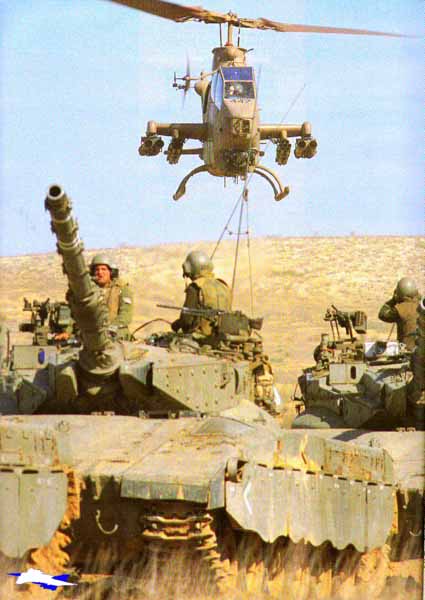

 www.youtube.com/watch?v=-5bJtVZe5Io
www.youtube.com/watch?v=-5bJtVZe5Io
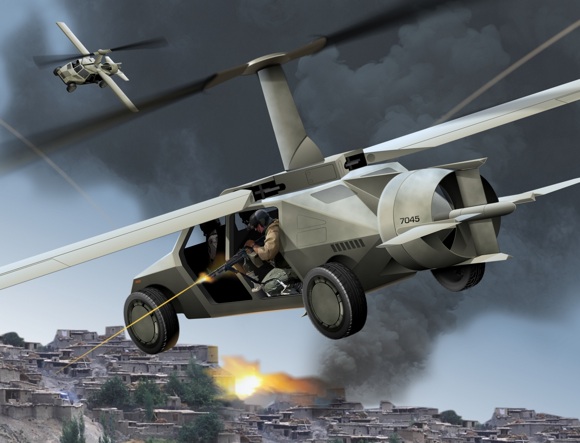
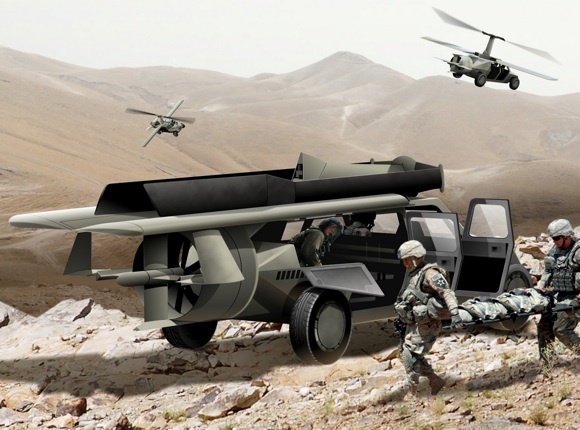
Military Review, 1992. Colonel Wallace P. Franz, Army of the United States, Retired is a graduate of Stanford University, He is a combat veteran of the Korean and Vietnam wars. In addition to serving on staff of the U.S. Army Command and General Staff College, Fort Leavenworth, Kansas, as the director, Simulations and War Gaming Branch, and director, Combat Theory, at the U.S. Army War College, Caldwell Barracks, Pennsylvania.
The post cold-war era presents a number of challenges for the U.S. military. On one hand, the United States emerges as the only true superpower, having just demonstrated its military prowess in the war with Iraq; on the other, defense spending is being cut, and the Armed Forces are being reduced in size. As the remaining superpower, the United States will be expected to act as such. How can the United States meet its commitments through-out the world in the face of a drastic reduction in the defense budget?
The recent Gulf War provides some significant insights about modern warfare. It appears that the United States will be able to maintain its air and naval superiority for years to come due to the excellence of its professional personnel and high- tech weapon systems. The United States had little trouble defeating one of the better-armed Third World nations. The Gulf War did point out the difficulty in moving heavy mechanized forces thousands of miles to a distant theater of operations. The shortage of strategic airlift and sealift is likely to continue due to a lack of funding in these areas. There is a need to study the effects of modern technology on ground forces and how they can be made more responsive to the requirements of the future. Can smaller, lighter Army units, through a combination of technology, speed and maneuver, produce the combat power required to defeat a heavy mechanized force anywhere in the world?
They can, by organizing and equipping Army combat aviation to function as a maneuver element with the ability to hold ground.
The U.S. Army is expected to reduce its personnel by 25 percent in the next few years. Aided by modern technology, Armies will move from labor-intensive to capital-intensive combat forces . . . . [It] will reduce its manpower requirements and increase its spending on land combat systems with enhanced mobility and firepower. The nature of land warfare continues to change as nations mechanize their armies. Modern "post-industrial" societies find it difficult to maintain large Armies due to fiscal restraints and
"The regiments are continually moving and attacking. Their areas of operations are not
The term "Airmechanization" signifies the intimate cooperation of armor and helicopters at tactical and lower operational levels, with the possibility of pure helicopter missions at a tactical level.
The characteristics of a force that will be required to fight as indicated above are:
Small, self-sufficient organizations.
. Highly mobile.
This dynamic type of combat places a high value on maneuver, stealth and disruption of the enemy's ability to act and react. It depends on the synergism of weapons employment and aggressive mission-oriented tactics. (3)
The doctrine expounded in Army 21 cannot be implemented with the current family of fighting vehicles, although the AH-64 Apache meets many of the requirements.
He goes on to explain that the term "Airmechanization'" signifies the intimate cooperation of armor and helicopters at tactical and lower operational levels, with the possibility of pure helicopter missions at a tactical level.
Throughout the history of warfare, mobility has been a decisive element in achieving victory. Generally, Armies have had five levels of mobility:
the boot,
The differences between these levels of mobility form the basis for maneuver superiority.
It was only after World War I that theorists discussed the use of wheels and tracks to mechanize large forces for operational maneuver. The German and Russian armies were the first to organize permanent mechanized units such as the division and the corps. These had mobility on order of magnitude greater than non-mechanized forces. As a result of this mobility, mechanized forces have won significant victories over their less mobile foes. By the 1960s, most advanced Armies had been mechanized; consequently, there was little difference in mobility between these Armies. Now as the main maneuver force approaches the physical limit of cross-country mobility, it must get off the ground to achieve mobility superiority over mechanized Armies.
The Soviet Army accomplished this in the form of its Airborne forces. The Soviets, with their emphasis on the operational art, have long considered Airborne and Air assault forces as operational formations. As long ago as the Airborne mechanized forces employed to achieve operational objectives. The Soviet approach to increasing mobility has been to combine light mechanized forces with fixed-wing aircraft to form light armored Airborne units.
See the early Russian Airborne in action in web page video clips here! AWESOME!
"There is no question that the Soviet Army has moved much further than any other, even than the U.S. Army in their 1986 structure, in the direction of Air-mechanisation integration of rotary-wing and armoured forces." (5)
The BMD Airborne Armored Personnel Carrier, for example, comes in a number of variants: the standard BMD with a 73mm low-pressure-cannon, BMD with 30mm automatic cannon, a BMD unarmed prime mover supply vehicle, BMD with 82mm or 120mm mortar and a BMD recon vehicle.
The Soviet light mechanized Airborne forces have been employed in stability operations throughout the Soviet Union and Afghanistan in recent years. The Soviets have continued to increase the number of Airborne battalions equipped with the BMD. A Soviet Airborne corps of three Airborne divisions could contain 27 x BMD-mounted battalions (some 99 BMDs), 150 close support self-propelled artillery pieces and about 750 air defense weapon systems. The presence of light armored vehicles raises the combat worth of a Soviet Airborne Division by an order of magnitude in giving it protected mobility after it has shed its fixed-wing mobility.
ASU-57: AIRMECHSTRIKE Victor in the Ogaden War in Africa
The Soviets employed this air-mobility in 1978. Russian General Vasily Petrov, using Cuban and Ethiopian units, conducted a successful Airmechanized maneuver against the Somalis in the Ogaden. He deployed a mixed helicopter and light armor force in the rear of the Somali Army defending the Kara Marda Pass. This Army was destroyed in three days. As an indication of the magnitude of this operation, 70 x ASU- 57 Airborne self-propelled assault guns were lifted into the landing zone by Soviet helicopters. The ASU-57 can transport six Soldiers in addition to its crew, thus giving Airmobile infantry some
ground mobility and firepower.
Today, rotary-wing aircraft offer the opportunity to exploit the ground mobility both at the tactical and operational levels. Up to now, the helicopter has been used primarily as a ground support system at the tactical level. The early history of the tank is similar to that of the armed helicopter. The tank in World War I was employed at the tactical level as an infantry support weapon; it was not conceived as operating independently of the infantry, or at a speed much faster than that of the infantry. Recently, several European military theorists have advocated the employment of major helicopter formations in operational roles. This concept goes well beyond the tactical employment of attack helicopter battalions to the maneuver of major airmobile formations over distances in excess of 300 kilo-meters (km).
Simpkin would add 470 helicopters to an armored division. This unit would have a total strength of 22,500 men. His Airmechanized concept is "the independent use of attack helicopters either tactically, as a stopgap block until the armor arrives; or operationally, to accelerate the development of critical points (Schwerpunkt) and enhance shock effect." a Simpkin combines an Air Assault and Armor force in his Airmechanized division.
General Frido von Senger, a former commander of NATO's central region, takes the Airrmechanized concept still further. His division is much smaller than Simpkin's. It has an attack helicopter brigade, an air transport brigade and an airmobile brigade of four infantry battalions. Von Senger sees the primary role of this division as an Army group or theater operational reserve. This force ecould be committed from a depth of 200 to 300 km after deployment of a forward C3 (command, control and communicantions) and logistic framework. Von Senger's division is an anti-armor force. Von Senger states:
"The Airmechanized force is to take no account of terrain obstacles; completely devastated areas and areas in which there is a highly dangerous amount of radioactivity must be of no significance. The vulnerability of Airmechanized force on the move and in the assembly areas is to be reduced by dispersal and its own air defense units to such an extent that it will be considerably less vulnerable than large land-bound columns and conglomerations of vehicles on roads."
An example of land and road-bound mechanized forces experiencing serious difficulties in maneuvering on the modern battlefield is given in the excellent book, Lebanon War. The authors of this work point out that this June 1982 campaign in Lebanon was the most detailed, planned large operation ever conducted by the Israelis. The following account covers some of the problems that even an excellent mechanized force encounters:
"The central drive up the Bekaa Valley was essentially one long, exhausting frontal attack, since the hilly terrain and mountain roads placed endless obstacles in the paths of the two flanking forces and prevented their unwieldy columns from fully expressing their power. Literally hundreds of the tanks sent into Lebanon never fired their guns, while the lead units bore the brunt of the fighting."
Von Senger goes on to say that today's technology offers possibilities that obviously reach far beyond the present type of attack helicopter. He believes an aircraft with the following characteristics could be produced in the near future:
. Maximum speed about 300 km per hour.
We can trace several approaches to the problem of gaining mobility superiority over ground mechanized forces.
The next step in the evolutionary process of Airmechanization is to incorporate the characteristics of the transporting vehicle with the fighting vehicle-the air vehicle with the land
vehicle. The means of transport must become the means of combat. We combine the operational mobility of the helicopter with the tactical mobility of the tank. We now have the "flying
tank" or Air/LandVehicle (A/LV) capable of holding
ground.
The Soviets have done this to some degree with their Hind series of helicopters, although their dismounted infantry forces are still vulnerable to ground mechanized forces. Western Airborne and Airmobile forces have difficulty holding ground against armor this is due to the combination of a lack of protected tactical mobility, and the light firepower of air-transported infantry. Airmechanized formations equipped with a suitable A/LV would have protected mobility and firepower and thus be able to hold ground while engaging enemy armor.
The Army is nearing the point where it can apply sophisticated aerospace technologies to ground combat vehicles. Composite armor, exhaust-reduction measures and sensor-jamming equipment are some of the new technologies that will make future combat vehicles lighter and yet more survivable. Equipped with a suitable vehicle, Army combat aviation employed as Airmechanized maneuver units could conduct the type of campaigns envisioned by the Army in the 21st century. An example of one approach to the creation of a suitable vehicle is given below. Advanced technology should make it possible within the next few years to develop an Air/Land family of vehicles of about 11 tons with
the following characteristics:
. Operational efficiency not significantly reduced by terrain, weather, climate or visibility.
2. Relatively low cost to produce and maintain.
. Revolutionary rotary propulsion.
This A/LV combines the characteristics of the tank, infantry fighting vehicle and the attack helicopter, and becomes the main battle A/LV. This vehicle family would include combat support and combat service support versions. The basic A/LV configuration can be used as the scout A/LV. We take a page from the transportation industry and its pre-packaged container concept. To the basic configuration can be added the following compartment pods (COPOs):
. Anti-armor/ anti-air weapon system (use the same weapon in both roles, weapon and re-arming capability are with the COPOP).
A function-based military support concept of replacement rather than repair and one-way logistics flow would be employed, using the basic Kevlar-covered COPO. Mission-dedicated, mass- produced, individually expendable platforms will support Airmechanization. The COPOS are armored and capable of having
The next step in the evolutionary process of Airmechanization is to incorporate the characteristics of the escorting vehicle with the fighting . . . . We combine the operational mobility of the helicopter with the tactical mobility of the tank. Airmechanized formations equipped with a suitable MV would have protected mobility and firepower and thus be able to hold ground while engaging enemy armor . . . . Composite armor exhaust-reduction measures and sensor-jamming equipment are some of the new technologies that will make future combat vehicles lighter and yet more survivable.
The bulk of the A/LVs could fly directly to the theater of operations, using a fuel COPO or re-fueling at sea. COPOS could be incorporated into the ground defense system with minimal engineer support. Empty fuel or water COPOS could be used for shelter or storage (remove self-sealing membrane from fuel COPO). An all-purpose ground vehicle would move COPOS on the ground. The ability of any A/LV to transport any type of COPO and the pre-packaged nature of the equipment give flexible options for use of future technological advances. Obsolescent COPOS can be discarded as new systems come on line and are incorporated into new COPOS.
The Airrnechanized force outlined above is capable of conducting operations as envisioned in Army 21, the Army's projection of war in the 21st century, which advocates maneuver warfare
employing a force with these characteristics:
. Capable of fluid, continuous operations.
Airmechanization will enable regiment-size forces to maneuver as never before. This type of unit can be dispersed over several hundred km and then concentrated in time and place to achieve surprise and overwhelming combat superiority. This concentration will take place on the battlefield only. Deception would be possible by massing in one direction and then dispersing only to concentrate on the real objective like a swarm of bees. The Joint Surveillance and Target Attack Radar System (J-STARS) is a battle-management air-to-ground equivalent of the Airborne Warning and Control System (AWACS). Its side-looking radar can pick out enemy ground targets up to 200 miles away.
Airmechanization will enable regiment-size forces to maneuver as
never before. This type of unit can be dispersed over several hundred km and then concentrated in time and place to achieve surprise and over-whelming combat superiority. This concentration will take place on the battlefield only.
allowing it to direct air, artillery or missile strikes against them. Such a system could control the Airmechanized units. Maneuver-based concepts plus technology can combine to produce the capability to destroy armies before they are deployed for combat-the large-scale ambush conducted by a major Airmechanized force to achieve operational objectives.
There have not been many historical examples of entire Armies being ambushed. The Romans suffered at least two major defeats due to ambushes; one in the Teutoburg Forest (by Arminius), the other at Lake Trasimene (by Hannibal). More recently, there was the ambush of Egypt's 25th Independent Tank Brigade by elements of Israel's 162nd Armored Division in October 1973.
New and innovative approaches must be applied to vehicle design. While a new form of propulsion is required to provide a suitable A/LV present technology can provide an interim A/LV that will assist the Army in achieving mobility superiority over its enemies with a light Airmechanized force, a force that can be deployed anywhere in the world in a few days.
NOTES
1. U.S. Department of the Army, Army 21, draft, 1984,.
SEE THE GRIFFON: 1st TSG (A)'S PROPOSAL FOR AN AIR/LAND COMBAT VEHICLE!
THE PAST: Flying Jeeps in the 1950/60s...
jedsite.info/transport/mike-number-us/m151_series/nortronics/nortronics-intro.html
NORTRONICS FLIGHT VEHICLE
* Contra-rotating two blade assembly above vehicle.
* Large compressed air tank in cargo space above turbine.
This was a proposed, but never produced, flying version of the M151. It was proposed by Nortronics System Support Limited, a division of the Northrop Corporation after the U.S. ARMY, asked Ford to look into the feasibility of a flying Jeep-type vehicle that could be used for observation purposes. Ford, who was building the M151 at the time, partnered with Nortronics to see if it could be made to fly. The proposed mode of power was a compressed air turbine which would have given the 4000lb vehicle a flight time of around 158 seconds. A full-sized production model was never made.
THE FUTURE: Flying Jeeps by DARPA
E-mail 1st TSG (A) itsg@hotmail.com
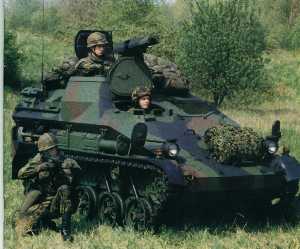
static. This gives the battlefield an amoeba-like appearance; that is, always changing. U.S. Army forces orient on the enemy, not on terrain. Regiments have the capacity to quickly change the direction of movement and attack to fight in any direction...there will be a series of semi-autonomous battles... in order to defeat forces that are superior in numbers, maneuver, mobility and austerity are required. We must scan the battlefield to seek out enemy vulnerabilities, rapidly concentrate our forces, strike hard and fast, and then scatter before he can bring to bear his combat power." (1)
. Firepower-intensive.
. Less manpower reliant.
. Extremely agile-with a dispersion and a massing capability.
. Capable of fluid, continuous operations.
. Rapidly deployable.
. Makes extensive use of robotics.
. Electronic warfare (EW) incorporated in all combat forces.
. EW to destroy, disrupt, deceive.
. Built-in mobility, counter-mobility, survivability.
. Information processing for logistics.
. Less fuel consuming- more energy efficient.
. Invisible equipment (multiple or stand-off signatures).
. Redundancy in command and control.
. Reconstitution capability.
. Tailored family of vehicles. (2)
[Editor: NOT TRUE. M113A3+ Gavin can be our "BMD", aircrew in AH-64s cannot take and hold ground--the whole point of this article advocating an air/LAND vehicle!.]
 www.youtube.com/watch?v=SwHqLtK_TpY
www.youtube.com/watch?v=SwHqLtK_TpY
Under nuclear parity, the development of combat vehicles has tended to stagnate. The Armored Fighting Vehicles of today are essentially what they were in World War I.
[Editor: Essentially true, but disagree--none of the WWI AFVs could carry troops or armored car. New and innovative approaches must be applied to the design of Armored Fighting Vehicles
using existing technology. Industry must meet this challenge and take the risks required and invest time and money to create a suitable land combat vehicle for the 21st century.
[Editor: that's the whole problem!!! Industry is taking all the risks! Where is the Army's responsibility to get off its ass and take some? What about LOYALTY? Is telling United Defense to build air-transportable M8 Buford Light tanks and then cancelling the program being loyal to industry? No, Col Franz, the problem here is H-Q-D-A.]
One approach to this problem, as outlined below, deals with Airmechanization and mobility. British Brigadier Richard E. Simpkin, the author of a number of works on armor warfare, has coined the term "airmechanized," and he states, "Use of helicopters in independent operations within the main mechanized battle-hence the term 'Airmechanized.'" (4)
the hoof,
the wheel or track,
the rotary-wing and the
fixed-wing aircraft.
[Editor: AMEN, brother. Wish we were "believers", too]
Later, rotary-wing aircraft were added to this formula. In his book Red Armour, Simpkin makes the following observation:
By the 1960s most advanced Armies had been mechanized; consequently, there was little difference in mobility between these armies. Now as the main maneuver force approaches the physical limit of cross-country mobility, it must get off the ground to achieve mobility superiority over mechanized Armies.
Soviet Airborne forces are equipped with light armored vehicles that provide mobility and firepower well beyond that of Western Airborne units. There is no Western equivalent to this family of Soviet Airborne vehicles: BMD (9 tons), BMP (11.5 tons), PT-76 (14 tons), ASU-85 (14 tons) and the ZSU-23-4 (14 tons).
[Editor: Col Franz and LTC Kazmierski must both have a blod clot or blocked neural pathways in their brains when the letters "M113A3" are joined together when neurological energy is directed towards "U.S. Army light AFVs". Both have overlooked THE greatest AFV of ALL TIME--IN U.S. Army possession that at 11 tons is and HAS BEEN FOR OVER 50 YEARS AN ABLE CANDIDATE FOR U.S. AIRMECHANIZATION!!!! HELLO???????]




. Cruising range about 600 meters.
. Payload about two tons; primarily weapon systems.
. Continuous hover capability.
"The Airmechanized force is to take no account of terrain obstacles; completely devastated areas [will] be of no significance. The vulnerability of Airmechanized force on the move and in the assembly areas is to be reduced by dispersal and its own air defense units to such an extent that it will be considerably less vulnerable than large land-bound columns and conglomerations of vehicles."
The Soviets have created a light mechanized force that can be transported by fixed or rotary-wing aircraft into the rear of the enemy Army. Simpkin would combine a large attack helicopter element with a heavy mechanized element in one division. Von Senger would organize his force around a powerful
attack helicopter element with a very small airmobile infantry element. Still, in the above examples, a variety of vehicles are required to move, to support and to fight.
[Editor: the key here to success is to make an AUTOGYRO a land combat vehicle, NOT a complicated helicopter. But why wait? We can give helicopters ground mobility TODAY by moving them in trailers, PLS flat racks by trucks and tracked armored transporters. The author also forgets to mention that ground maneuver units that can FLY THEMSELVES don't have to "mother, may I?" beg airlift from fly boys in separate unit bureaucracies which takes time and loses opportunities to win battles. Do-It-Yourself Air-Mech (DIY-AMS) ]
 www.youtube.com/watch?v=xBHP_8mycgc
www.youtube.com/watch?v=xBHP_8mycgc
1. Mobility: strategic, operational and tactical.
. Provide protection against small-arms fire and shell fragments through the use of Kevlar wrap-around laminated armor.
. Energy efficient, extended range out to 1,000 km and speed of 500 kph.
. Ground mobility without the use of rotors.
. Heavy weapons using rocket- assisted kinetic energy (RAKE) projectiles and fuel/air munitions.
. Troop carrying/ medical evacuation.
. Advanced radar and electronics.
. Engineer and countermobility.
. Supply: fuel, water, ammunition, food.
. Ground vehicle.
Figure 1. Air/Land vehicle
additional composite armor added. Normally the basic A/LV would be more heavily protected than the COPO. The COPO can be attached or removed from the basic A/LV within a few seconds. Various COPO configurations could be pre-packed and loaded into C-141 or other cargo aircraft for strategic deployment.
. Highly mobile.
. Extremely agile dispersion and massing
capability.
. Firepower intensive.
. Rapid strategic deployability.
2. Ibid., 4 and 48,
6. Simpkm, Arrnoc 56.
3. Ibd., 30 and 31.
7. F. M. von Seger, "New Operational Dimensions," lecture given at the Royal United Service Institution on 2 February 1983, 15.
4. Brigadier Richard E. Simpkin, "An Airmechanized Force for the 90s," Armor
8. Ze'ev Schii and Ehud Ya'an, kraelk Lebanon War( New York: Simon and (July- A USA 1981): 54. ? Schuster, 1984), 172
5 Richard E. Simpkin, Red Amour: An Examination of the Soviet Union
9. Von Senger,
12.
Force Comet (Oxford, England: Brassey's Defence Publishers, 1984), 177,
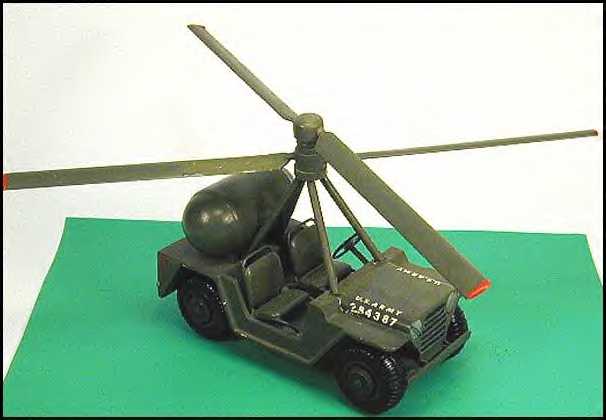
TRUCK, 4X4 ¾ ENHANCED MOBILITY


The proposed DARPA flying jeep above is a helicopter--like the 1950s model with contra-rotating rotors.
FEEDBACK!